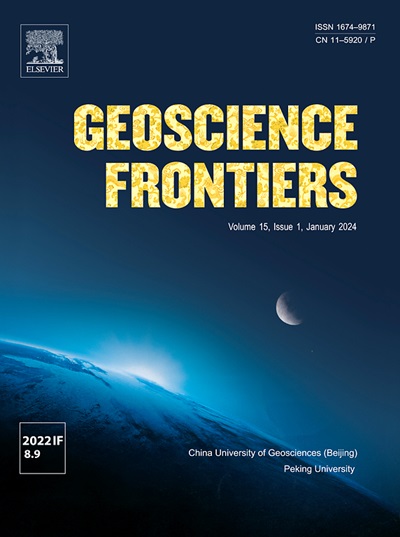青藏高原东南部岩石圈变形与地震构造:多地球物理资料联合反演的整体视角
IF 8.5
1区 地球科学
Q1 GEOSCIENCES, MULTIDISCIPLINARY
引用次数: 0
摘要
青藏高原东南部(SETP)在新生代与印亚辐合有关的复杂青藏高原与华南地块之间的地壳变形中起着关键的调节作用。本研究通过联合反演多地球物理观测资料,建立了SETP的高分辨率三维岩石圈结构模型,了解其新生代渐进变形过程、深部地震构造环境以及区域地球动力机制。在峨眉山大火成岩省(ELIP)内带下方,我们确定了两个低密度带,它们被一个明显的高密度体所分隔。我们还成像了SETP下地壳中相互连接的通道流。为了进一步确认新生代变形传播与深部岩石圈构造的关系,我们从多地球物理观测资料联合反演的整体角度出发,结合SETP主要走滑断裂带和区域构造的几何运动学特征进行综合分析。结果表明:SETP中下地壳具有低有效弹性厚度(Te)、高热流、低密度/速度和低粘度的力学弱特征,可能容纳了韧性流动,为青藏高原地壳物质的侧向挤压提供了重要通道,最终导致SETP的幕式岩石圈变形。研究结果表明:始新世—早渐新世的地壳纬向缩短和增厚,晚渐新世—早中新世的顺时针旋转和沿主要走滑断裂的侧向挤压,以及中新世中晚中新世伴随区域运动反转的下地壳流动,是SETP在新生代的三个主要变形阶段。岩石圈的变形、流体的侵入和深部熔融物质的上涌有利于应变的积累,这也可以解释大地震的发生。在地球动力学上,我们认为印度-亚洲辐合带的辐合速率、俯冲角和过程的时空变化可能与SETP的幕式地壳变形和强烈地震活动有关。弱中下地壳中的含水流体可能在长期的重力驱动下向外传播,导致了SETP的岩石圈变形和地震活动。此外,印度俯冲板块的后退以及西太平洋板块的回滚和弧后扩张也为青藏高原的东挤压提供了有利条件。本文章由计算机程序翻译,如有差异,请以英文原文为准。

Lithospheric deformation and seismotectonics in the southeastern Tibetan Plateau: A holistic perspective from joint inversion of multi-geophysical data
The southeastern Tibetan Plateau (SETP) plays a pivotal role in accommodating the crustal deformation between the complex Tibet Plateau and the South China Block during the Cenozoic associated with the India-Asia Convergence. In this study, we establish a high-resolution 3-D lithospheric structure model of the SETP through joint inversion of observable multi-geophysical data, to understand its Cenozoic progressive deformation processes, deep seismotectonic environment, as well as regional geodynamic mechanism. We identify two low-density zones within the mid-lower crust that are separated by a pronounced high-density body beneath the inner zone of the Emeishan Large Igneous Province (ELIP). We also image an interconnected channel flow in the lower crust beneath the SETP. To further confirm the relationship between Cenozoic deformation propagation and deep lithospheric architecture, we adopt a holistic perspective from joint inversion of observable multi-geophysical data, coupled with integrated analysis on geometric-kinematic characteristics of major strike-slip fault zones and regional tectonics in the SETP. The results show that the mechanically weak mid-lower crust of the SETP is characterized by low effective elastic thickness (Te), high heat flow, low-density/velocity and low-viscosity, which might accommodate the ductile flow and provide an important channel for the lateral extrusion of crustal materials from the Tibetan Plateau, and ultimately contribute to the episodic lithospheric deformation of the SETP. We trace three main phases of deformation within the SETP during the Cenozoic: the Eocene-early Oligocene latitudinal crustal shortening and thickening, the late Oligocene-early Miocene clockwise rotation and lateral extrusion along major strike-slip faults, and the mid-late Miocene lower crustal flow accompanied with regional kinematic reversal. The lithospheric deformation, the invasion of fluids and the upwelling of deep molten materials are conducive to strain accumulation, which might also explain the occurrence of large earthquakes. Geodynamically, we consider that both the spatio-temporal variance of convergent rates, subduction angle, and processes of the India-Asia Convergence may be associated with episodic crustal deformation and intense seismicity in the SETP. The aqueous fluids in the weak mid-lower crust may have propagated outward due to the long-term gravitational driving forces and contributed to the lithospheric deformation and seismicity of the SETP. Furthermore, the retreat of the subducted Indian slab as well as the rollback and back-arc spreading of the western Pacific Plate also provided favorable conditions for the eastward extrusion of the Tibetan Plateau.
求助全文
通过发布文献求助,成功后即可免费获取论文全文。
去求助
来源期刊

Geoscience frontiers
Earth and Planetary Sciences-General Earth and Planetary Sciences
CiteScore
17.80
自引率
3.40%
发文量
147
审稿时长
35 days
期刊介绍:
Geoscience Frontiers (GSF) is the Journal of China University of Geosciences (Beijing) and Peking University. It publishes peer-reviewed research articles and reviews in interdisciplinary fields of Earth and Planetary Sciences. GSF covers various research areas including petrology and geochemistry, lithospheric architecture and mantle dynamics, global tectonics, economic geology and fuel exploration, geophysics, stratigraphy and paleontology, environmental and engineering geology, astrogeology, and the nexus of resources-energy-emissions-climate under Sustainable Development Goals. The journal aims to bridge innovative, provocative, and challenging concepts and models in these fields, providing insights on correlations and evolution.
 求助内容:
求助内容: 应助结果提醒方式:
应助结果提醒方式:


